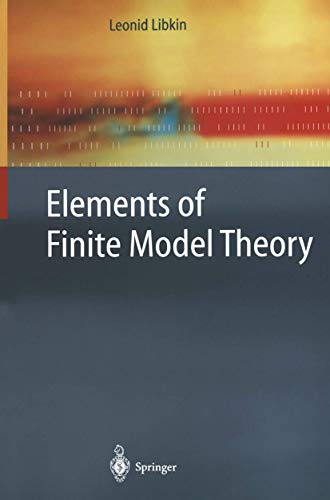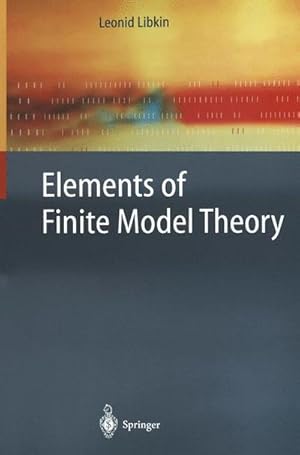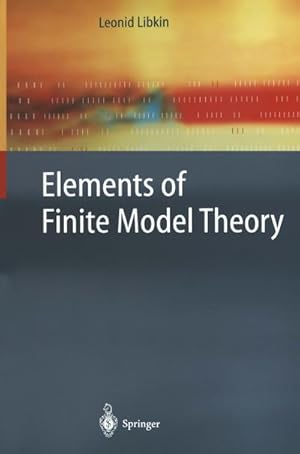Elements Finite Model Theory by Libkin Leonid (36 results)
Search filters
Product Type
- All Product Types
- Books (36)
- Magazines & Periodicals (No further results match this refinement)
- Comics (No further results match this refinement)
- Sheet Music (No further results match this refinement)
- Art, Prints & Posters (No further results match this refinement)
- Photographs (No further results match this refinement)
- Maps (No further results match this refinement)
- Manuscripts & Paper Collectibles (No further results match this refinement)
Condition Learn more
- New (23)
- As New, Fine or Near Fine (7)
- Very Good or Good (5)
- Fair or Poor (No further results match this refinement)
- As Described (1)
Binding
Collectible Attributes
- First Edition (No further results match this refinement)
- Signed (No further results match this refinement)
- Dust Jacket (1)
- Seller-Supplied Images (20)
- Not Print on Demand (28)
Language (1)
Free Shipping
Seller Location
Seller Rating
-
Softcover. Condition: Very good. Great condition. Cover and edges are slightly worn. Inside is clean and unmarked.
-
Elements of Finite Model Theory (Texts in Theoretical Computer Science. An EATCS Series)
Seller: thebookforest.com, San Rafael, CA, U.S.A.
Condition: Like New. Text block, wraps and binding are in like new condition, without markings of any kind. Supporting Bay Area Friends of the Library since 2010. Well packaged and promptly shipped.
-
Elements of Finite Model Theory (Texts in Theoretical Computer Science. An EATCS Series)
Seller: HPB-Red, Dallas, TX, U.S.A.
hardcover. Condition: Good. Connecting readers with great books since 1972! Used textbooks may not include companion materials such as access codes, etc. May have some wear or writing/highlighting. We ship orders daily and Customer Service is our top priority!
-
Elements of Finite Model Theory (Texts in Theoretical Computer Science. An EATCS Series)
Seller: World of Books (was SecondSale), Montgomery, IL, U.S.A.
Condition: Very Good. Item in very good condition! Textbooks may not include supplemental items i.e. CDs, access codes etc.
-
Hardcover. D03769 Ex-library with Stamp and Library-Signature in Good Condition, Some Traces of Use 9773540212028 Sprache: Englisch Gewicht in Gramm: 550.
-
Elements of Finite Model Theory (Texts in Theoretical Computer Science. An EATCS Series)
Seller: Bartleby's Books, Wilmington, VT, U.S.A.
Hardcover. Condition: Used - Very Good. Dust Jacket Condition: Very Good.
-
Condition: New.
-
Elements of Finite Model Theory (Texts in Theoretical Computer Science. An EATCS Series)
Seller: Lucky's Textbooks, Dallas, TX, U.S.A.
Condition: New.
-
Condition: New.
-
Elements of Finite Model Theory (Texts in Theoretical Computer Science. An EATCS Series)
Seller: Lucky's Textbooks, Dallas, TX, U.S.A.
Condition: New.
-
Elements of Finite Model Theory (Texts in Theoretical Computer Science. An EATCS Series)
Seller: Ria Christie Collections, Uxbridge, United Kingdom
US$ 114.04
US$ 15.77 shipping from United Kingdom to U.S.A.Quantity: Over 20 available
Add to basketCondition: New. In.
-
Elements of Finite Model Theory (Texts in Theoretical Computer Science. An EATCS Series)
Seller: Ria Christie Collections, Uxbridge, United Kingdom
US$ 114.04
US$ 15.77 shipping from United Kingdom to U.S.A.Quantity: Over 20 available
Add to basketCondition: New. In.
-
Condition: Good. This is an ex-library book and may have the usual library/used-book markings inside.This book has soft covers. In good all round condition. Please note the Image in this listing is a stock photo and may not match the covers of the actual item,600grams, ISBN:9783642059483.
-
US$ 114.03
US$ 19.74 shipping from United Kingdom to U.S.A.Quantity: Over 20 available
Add to basketCondition: New.
-
US$ 114.03
US$ 19.74 shipping from United Kingdom to U.S.A.Quantity: Over 20 available
Add to basketCondition: New.
-
PF. Condition: New.
-
Condition: New. pp. 336.
-
US$ 133.35
US$ 19.74 shipping from United Kingdom to U.S.A.Quantity: Over 20 available
Add to basketCondition: As New. Unread book in perfect condition.
-
Elements of Finite Model Theory (Texts in Theoretical Computer Science. An EATCS Series)
Seller: BennettBooksLtd, San Diego, NV, U.S.A.
hardcover. Condition: New. In shrink wrap. Looks like an interesting title!
-
Taschenbuch. Condition: Neu. Elements of Finite Model Theory | Leonid Libkin | Taschenbuch | xiv | Englisch | 2010 | Springer | EAN 9783642059483 | Verantwortliche Person für die EU: Springer Verlag GmbH, Tiergartenstr. 17, 69121 Heidelberg, juergen[dot]hartmann[at]springer[dot]com | Anbieter: preigu.
-
Elements of Finite Model Theory
Published by Springer Berlin Heidelberg, Springer Berlin Heidelberg Jul 2004, 2004
ISBN 10: 3540212027 ISBN 13: 9783540212027
Language: English
Seller: buchversandmimpf2000, Emtmannsberg, BAYE, Germany
Buch. Condition: Neu. Neuware -Finite model theory is an area of mathematical logic that grew out of computer science applications. The main sources of motivational examples for finite model theory are found in database theory, computational complexity, and formal languages, although in recent years connections with other areas, such as formal methods and verification, and artificial intelligence, have been discovered. The birth of finite model theory is often identified with Trakhtenbrot's result from 1950 stating that validity over finite models is not recursively enumerable; in other words, completeness fails over finite models. The tech nique of the proof, based on encoding Turing machine computations as finite structures, was reused by Fagin almost a quarter century later to prove his cel ebrated result that put the equality sign between the class NP and existential second-order logic, thereby providing a machine-independent characterization of an important complexity class. In 1982, Immerman and Vardi showed that over ordered structures, a fixed point extension of first-order logic captures the complexity class PTIME of polynomial time computable propertiE~s. Shortly thereafter, logical characterizations of other important complexity classes were obtained. This line of work is often referred to as descriptive complexity. A different line of finite model theory research is associated with the de velopment of relational databases. By the late 1970s, the relational database model had replaced others, and all the basic query languages for it were es sentially first-order predicate calculus or its minor extensions.Springer Verlag GmbH, Tiergartenstr. 17, 69121 Heidelberg 336 pp. Englisch.
-
Elements of Finite Model Theory
Published by Springer Berlin Heidelberg, 2010
ISBN 10: 3642059481 ISBN 13: 9783642059483
Language: English
Seller: AHA-BUCH GmbH, Einbeck, Germany
Taschenbuch. Condition: Neu. Druck auf Anfrage Neuware - Printed after ordering - Finite model theory is an area of mathematical logic that grew out of computer science applications. The main sources of motivational examples for finite model theory are found in database theory, computational complexity, and formal languages, although in recent years connections with other areas, such as formal methods and verification, and artificial intelligence, have been discovered. The birth of finite model theory is often identified with Trakhtenbrot's result from 1950 stating that validity over finite models is not recursively enumerable; in other words, completeness fails over finite models. The tech nique of the proof, based on encoding Turing machine computations as finite structures, was reused by Fagin almost a quarter century later to prove his cel ebrated result that put the equality sign between the class NP and existential second-order logic, thereby providing a machine-independent characterization of an important complexity class. In 1982, Immerman and Vardi showed that over ordered structures, a fixed point extension of first-order logic captures the complexity class PTIME of polynomial time computable propertiE~s. Shortly thereafter, logical characterizations of other important complexity classes were obtained. This line of work is often referred to as descriptive complexity. A different line of finite model theory research is associated with the de velopment of relational databases. By the late 1970s, the relational database model had replaced others, and all the basic query languages for it were es sentially first-order predicate calculus or its minor extensions.
-
Elements of Finite Model Theory (Texts in Theoretical Computer Science. An EATCS Series)
Seller: AHA-BUCH GmbH, Einbeck, Germany
Hardcover. Condition: Neu. Neu Neuware, auf Lager - Finite model theory is an area of mathematical logic that grew out of computer science applications. The main sources of motivational examples for finite model theory are found in database theory, computational complexity, and formal languages, although in recent years connections with other areas, such as formal methods and verification, and artificial intelligence, have been discovered. The birth of finite model theory is often identified with Trakhtenbrot's result from 1950 stating that validity over finite models is not recursively enumerable; in other words, completeness fails over finite models. The tech nique of the proof, based on encoding Turing machine computations as finite structures, was reused by Fagin almost a quarter century later to prove his cel ebrated result that put the equality sign between the class NP and existential second-order logic, thereby providing a machine-independent characterization of an important complexity class. In 1982, Immerman and Vardi showed that over ordered structures, a fixed point extension of first-order logic captures the complexity class PTIME of polynomial time computable propertiE~s. Shortly thereafter, logical characterizations of other important complexity classes were obtained. This line of work is often referred to as descriptive complexity. A different line of finite model theory research is associated with the de velopment of relational databases. By the late 1970s, the relational database model had replaced others, and all the basic query languages for it were es sentially first-order predicate calculus or its minor extensions.
-
Elements of Finite Model Theory (Texts in Theoretical Computer Science. An EATCS Series)
Seller: Mispah books, Redhill, SURRE, United Kingdom
Hardcover. Condition: Like New. LIKE NEW. SHIPS FROM MULTIPLE LOCATIONS. book.
-
US$ 196.54
US$ 19.74 shipping from United Kingdom to U.S.A.Quantity: Over 20 available
Add to basketCondition: As New. Unread book in perfect condition.
-
Condition: As New. Unread book in perfect condition.
-
Elements of Finite Model Theory (Texts in Theoretical Computer Science. An EATCS Series)
Seller: Mispah books, Redhill, SURRE, United Kingdom
Paperback. Condition: Like New. Like New. book.
-
Condition: As New. Unread book in perfect condition.
-
Elements of Finite Model Theory
Published by Springer Berlin Heidelberg Dez 2010, 2010
ISBN 10: 3642059481 ISBN 13: 9783642059483
Language: English
Seller: BuchWeltWeit Ludwig Meier e.K., Bergisch Gladbach, Germany
Taschenbuch. Condition: Neu. This item is printed on demand - it takes 3-4 days longer - Neuware -Emphasizes the computer science aspects of the subject.Details applications in databases, complexity theory, and formal languages, as well as other branches of computer science. 336 pp. Englisch.
-
Elements of Finite Model Theory
Published by Springer Berlin Heidelberg Jul 2004, 2004
ISBN 10: 3540212027 ISBN 13: 9783540212027
Language: English
Seller: BuchWeltWeit Ludwig Meier e.K., Bergisch Gladbach, Germany
Buch. Condition: Neu. This item is printed on demand - it takes 3-4 days longer - Neuware -Emphasizes the computer science aspects of the subject.Details applications in databases, complexity theory, and formal languages, as well as other branches of computer science. 336 pp. Englisch.



















